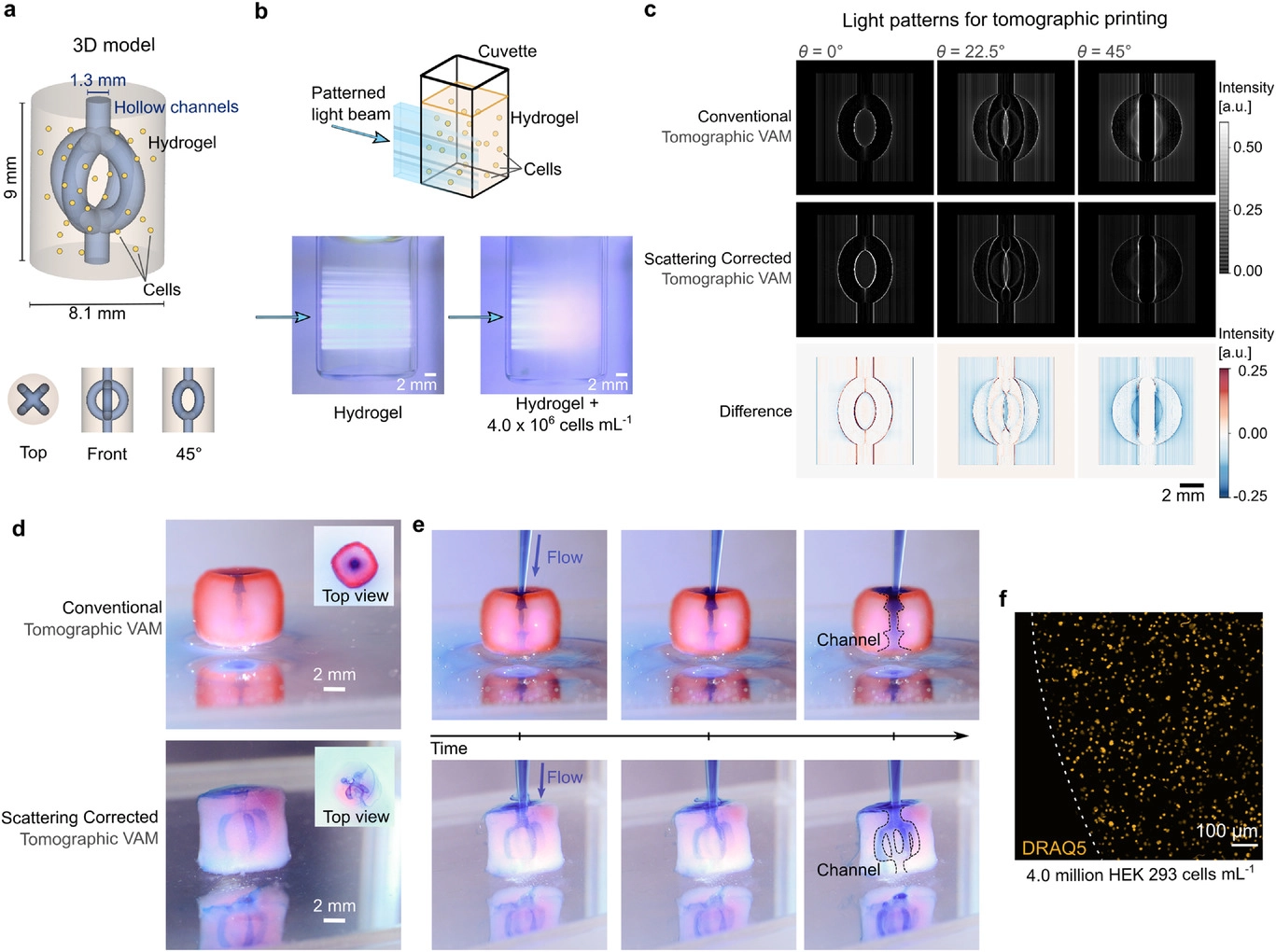
The work was carried out by a team consisting of researchers from the Laboratory of Applied Photonics Devices, School of Engineering, Ecole Polytechnique Fédérale de Lausanne and startup
Readily 3D. You may recognize Readily for its volumetric
Tomolite bioprinter. In its paper, the team explained how it was able to correct for light scattering in opaque resins:
“We proposed to make a correction based on a spatial frequency analysis of a stack of images captured with a side-view camera, perpendicular to the optical axis. Corresponding experimental data reveal the poor transmission of high spatial frequencies due to light scattering by the photocurable resin,” the team wrote. “Following this image analysis, a numerical correction can be performed to compensate for this frequency-dependent attenuation by accentuating the features of highest spatial frequencies. The resulting corrected light dose presents an increased contrast compared to the standard binary map conventionally used. Through the printing of several object geometries in two different scattering materials (acrylics and hydrogel-based resins), we demonstrate that the correction improves printing fidelity and resolution.”
The researchers believe that their approach can be applied to other volumetric 3D printing technologies, as well. However, they do qualify their work in stating that a lot of resins will scatter light way beyond what is reasonably correctable. For now, the team specifically looked at highly loaded cell-laden hydrogels adapted through contrast agents. The team first examined the scattering effects and corresponding changes to the digital micromirror device (DMD) to correct for these effects.

“Scattering-corrected tomographic volumetric additive manufacturing (VAM) allows to print complex geometries with hollow channels in scattering materials, such as cell-laden hydrogels. a) A 3D model of an object with a core surrounded by four interconnected hollow channels. b) Example of a hydrogel containing 4 million cells mL−1. The text written behind a typical vial used for printing is not readable due to light scattering by the cells in suspension. c) In conventional tomographic VAM, the 3D model is binarized into a computed light dose that is used to calculate the set of patterns for printing. When these patterns are projected onto the scattering material, they are blurred and the resulting deposited light dose prevents from printing the target object. d) In scattering-corrected VAM, the 3D model is transformed into a continuous light dose that accounts for light distortions by the gel. The projection of the corresponding light patterns produce a print that matches the geometry and the function of the target 3D model.”
Used in digital light processing (DLP) and other 3D printing techniques, the DMD is where millions of tiny mirrors are manipulated to generate an image. By changing the amplitude and angle of the mirrors in the DMD through a correction mask, the team hopes to correct the attenuation and distortion of light in the resin. Their correction method is such that intensity is greatest at the center of parts where it is needed most. Normally, this cannot be done because you’d have to do this by overexposing a section of the vat in order to adequately expose an interior area. Their technique, which they also refer to as “scattering corrected volumetric additive manufacturing”, can also increase print fidelity compared to other volumetric methods.
Their technique is especially viable for bioprinting hollow channels, convenient because this has historically been rather difficult to do. It is, however, essential since hollow channels are needed to provide nutrients and oxygen to printed tissue. It is in 3D printed hydrogel hollow channels that the team therefore envision its work to be the most relevant.

“Bio-fabrication of a functional vascular model in cell-laden hydrogels. a) 3D model of a construct with a core surrounded by four channels, emulating vasculature. b) Side-view of how light is blurred as it penetrates into the hydrogel with cells. c) Corresponding light patterns projected at different angles during tomographic VAM with and without correction. The difference shows by where and by how much is the correction applied to account for scattering d) Photographs of the resulting printed constructs after dying them in red. e) Timelapses of a blue dye flowing through the constructs. The scattering corrected tomographic VAM produces an object that matches the geometry and function of the model; while conventional tomographic VAM results in an unintended malfunctioning tube at the center of the construct. f) Fluorescence microscopy image of stained nuclei of cells in the fabricated hydrogels (4.0 million cells mL−1).”
This is good news for the participating researchers from Readily3D (and another Ecole Polytechnique Fédérale de Lausanne researcher who is a shareholder). Readily3D advises that its bioprinter uses a low photoinitiator dose and “shaped light beams from multiple angles” to produce constructs. The main feature is, of course, that because the “entire build volume is illuminated simultaneously, centimeter-scale biological systems are produced in just tens of seconds. After printing, the object is simply separated from the uncured ink and collected.”
Low photoinitator doses will of course help mitigate cell death which is a continuous issue with light based bioprinting methods. At the moment, the printer can build objects 27mm high with a diameter of 12.5mm in hydrogels, silicones, and acrylics.
The speed of volumetric printing is very exciting, but this team may yet have improved upon it in a very significant way. The team also may have some valuable IP on its hands that it could license to other firms playing in the space. Bioprinting is to be a very long race, a marathon not a sprint. Firms will have to have war chests or continuous revenue to survive the current dearth of funding and emerge at a time when bioprinting is more mature and ready to treat patients. Due to this, it is tough to pick the winners now, but this technology would be an interesting thing to have in anyone’s arsenal—most of all 3D Systems.
Image courtesy of Advanced Science.


































